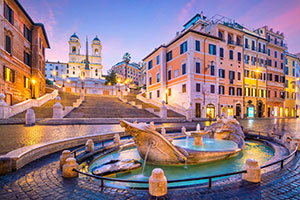Castellina
If we want to find the on em of Castellina in Chianti we have to go far back to the beginning of history. These hills,sometimes wild,often softly rolling, still indicate that mankind has been using them for different purposes at least since the 7th century B.C. Towns and settlements founded during this period and located along the most important donkey tracks leadine from the
mountains down to Castellina in Chianti, are still proof of a communication link between the large Mediteranian Etruscan cities like Vulci, Vetulonia and Roselle. s well as the famous tradine centers of the North like Spina. The latter used to be the most important trading harbour of the Adriatic Sea, and therefore was considered to be the only gate to the Orient.
The archaeological findings of Castellina in Chianti and its surrounding area are plentiful and important. The impressive tomb of Monte Calvano has a diameter of approx. 53 meters and is located outside of Castellina in the direction of Greve. The name den ves from a small chapel built on the highest point of this hill, describing and showine the last station of the Via Crucis. the Way of the Cross. This tomb contains four underground burial places. There is one big depth chamber as well as lateral smaller cells.. The tomb was built by stacking crude limestone shingles and was then closed with a projecting construction of huge stone flags. Each one of these four burial places indicates one of the four cardinal points.
Discovered and immediately plundered during the 16th century A.C. this tomb was rediscovered and laid open in 1915 by archaeologists, who found bronze and iron ornaments from a etruscian 'war cart'. Among all these findings,a lion's head. carved out of sandstone, draws special attention. Based upon these findings. it was possible to date this tomb to the 7th century B.C. (that means in the fully orientalists period in Etruria).
In a northerly direction, along the road leading to San Donato in Poggio. you can still see the walls surrounding an acropolis, housing a still perfectly functioning well. At present the whole site is still an archaeological excavation ground To the South. on the ancient old mad. in the region of Poggino, east of the small settlement of Fonterutoli, and in the direction of Siena. a small necropolis was discovered and excavated. So far. this burial place contains five tombs, four with death chambers and one small rectangular chamber shaped as a 'Caisson'. Equipment found among the burial objects prove that rich families of noble birth lived in this region during the whole period of the 6th centruy B.C. This is attributed to the Archaic Period, a magnificent age in the history of the Etruscan people who. according to Dionigi of Alicarnasso, were '... not be compared to any other period.'
Fragments as well as parts of the excavated burial site. or votiv gifts can be seen in the atrium ofthe medieval castle which now houses the local adminstration. Among other exhibits there are two Attiejugs with black figure paintings, Etruscan Corinthian ceramic perfume oil-flasks - produced in Vulci and others made of a glassy paste. ornaments and arms made of iron and bronze. Etruscan settlements can be traced as far back as the 7th centrury B.C, but a drastic and tragic end ensued. Only traces ofsudden destruction by fire remain of the vanished Etruscan people. Political and cultural borderlines, once drawn between the mighty Etruscan community regions and cities of Volterra, Chiusi and Fiesole, are still in evidence in the clerical separation of Castellina in Chianti, even today three different dioceses, Siena. Arezzo and Fiesole, govern this small town.
Information on later periods and on the barbarian assaults in the region are sparse. One of the few records on Castellina in Chianti is the mention of the property transfer of this castle to the nobles of the nobles castel of Trebbio. These were vassals of Count Guidi who erned under Longobard law and who can be traced hack to a notary document of the year 1220 drawn up by the Emperor Frederick II. This region was then put under the government of the citv of Florence. And again Castellina in Chianti functioned as 3 borderline between Florence, and her arch-enemy Siena. Since the 13th century A.D. Castellina is part of the 'Lega del Chianti', meaning 'Chianti Alliance'.
This was an administrative and military alliance within the state of Florence. Because of its optimal strategic location which guaranteed the control of all surrounding roads, as well as the whole valley of the EIsa river. Castellina retained its military position. Proof of this is the existence of the imposing fortress, nowadays used by the local town government.
Castellina was once surrounded by mighty walls and smaller towers, only two gates interrupted the closed defence line. One pointed towards Siena. the other towards Florence. Unfortunately both gates were completely destroyed (the gate towards Florence was destroyed during battles in the second World War). Parts of the defending waIls can still be seen today. Unfortunately most parts have been covered over or been integrated into the later construction of houses. Battles, sieges and conflicts have accompanied the daily life for centuries. The rattling of sabres, hollow cannon impacts and nerve-wracking shooting, noises of the new fire arms - all this was daily routine. Always different was the outcome of the fighting: in 1397 Alberico da Barbiano, in the service of the Duke of Milan took Castellina by stoim and occupied it. In 1452 the town had to defend itself against the troops of Ferdinand of Aragon; it surrendered after 44 days of siege. In 1478 Castellina had again to surrender after being stormed in an extremely long siege by the Duke ofCalabria. That Lorenzo iT Magnifico, then ruler of Florence, sent his famous architect, Giuliano da Sangallo to Castellina to help reinforce and improve the strategically important defence points did not help.
During this hard siege severe assaults one of a new weapon system, such as artillery, were introduced. During this hard siege severe assaults one of a new weapon system, such as artillery, were introduced. Furthermore, poisoned rifle ammunition was used. The so-called 'medicine bullets'. All this is told by Baldassar Castiglione in the 'Cortigiano'. In 1483 Castellina was once again returned to the Medici. Due to the surrender of Siena to the troops of Karl V in April 1555 and the
following annexation of the State of Siena, Castellina in Chianti lost its strategic importance and became a part of the dominion of the Grand Duchy of Tuscany. Now the tumult of warfare ceased; now people turned to the sounds of agricultural machinery. The numbers offarmers increased, and as a result of their great efforts under extremely unfavourable conditions, the countryside around Castellina began to transform into what we have come to love and admire today. The most important events of this time were the repeated visits of the Grand Dukes Ferdinand III and Leopold II, which brought some distraction from everyday worries to the people. In 1944, Castellina in Chianti was the site ofa brief but very intense fight. The unevenness of the landscape put the retreating German troops to advantage.
They were able to build up such an effective defense line that its destruction cost many deaths among the civilians of Castellina and also resulted in the distruction of monuments. such as the old Florentine city gate as well as the old church of S. Salvatore.






